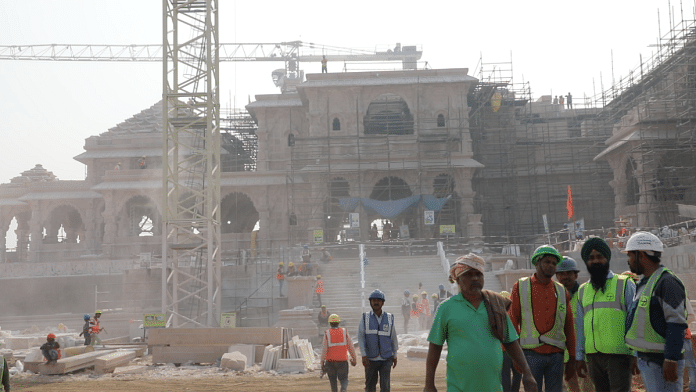Ayodhya: The Ram Mandir in Ayodhya drew its inspiration from north and south Indian temple architecture giving it a pan-India appeal.
Drawing from the north’s Nagara style of architecture, the temple also incorporates elements from the renowned South Indian shrines in Rameshwaram, Tirupati and Kanchipuram, the temple design construction manager, Girish Sahastrabhojini said Tuesday.
“Ram Temple has a beautiful blend of Indian architecture. It has a semblance of Dravidian architecture assimilated within the Nagara style,” he told ThePrint.
Built on a high platform, Nagara temples are recognizable by its tall, pyramidal towers called shikharas. While the main temple where the statue of Lord Ram will be kept is in Nagara style, Sahastrabhojini said, the four temples at the corners are influenced by Dravadian architecture.
The Ram Mandir is set to be inaugurated on 22 January, and it will be completed by 2025.
On Tuesday, media personnel were given limited access to the under-construction temple where engineers, members of Vishva Hindu Parishad (VHP) and Ram Janmabhoomi Trust secretary Champat Rai briefed them about the temple architecture.
Initially, architects wanted to carve the famous South Indian Gopuram style of entrance but the paucity of land didn’t allow them to incorporate that. So, they decided to pick some elements from that architecture to give it a broader South Indian temple look.
“In southern temples, everywhere you will see Gopuram. But it was not possible here. So we took different elements from the South Indian architecture,” Sahastrabhojini said.
Also Read: ‘Celebrate like it’s Diwali’: Ahead of Ram temple opening, RSS to organise countrywide Kalash Yatra
‘Construction material sourced from across India’
Granite used in the construction was sourced from Telangana and Karnataka, flooring material from Madhya Pradesh, and superstructure from Rajasthan. Skilled sculptures from Odisha did intricate sandstone cravings — an ensemble of materials sourced from different parts of India.
“Woodwork was assigned to an Andhra Pradesh-based company with workers from Tamil Nadu. Brassware was sourced from Uttar Pradesh, and the gold work from Maharashtra. The chief architect of the temple is a Gujarati,” Sahastrabhojini said.
As for the workforce, construction major Larsen and Toubro engaged about 4,000 workers including local stone carvers for chiselling stones and craftsmen from Rajasthan and Mysuru.
“Currently, the first floor of the temple is fully established along with the flooring and entrance. The sanctum where Lord Ram will be kept is also ready. The second and third floors are under construction,” Rai said.
No steel, iron used in superstructure
The construction of Ram temple came with its own set of challenges, recalled Sahastrabhojini.
Historically, the Saryu river flowed in proximity to the temple premise making the soil loose and weak. “We replaced the soil and went for an engineering fill with lean concrete. Before construction, one would like to choose a place where you can economise on the expenses. But here, the place was already chosen by Lord Ram. So, we had to calibrate our own intelligence and sense of engineering to match his expectation,” Sahastrabhojini told ThePrint.
No steel and concrete has been used in the construction of the temple. To ensure that the temple stands for a thousand years, no modern materials such as carbon fibre, glass rod and composite materials were used, he said. The aim was that the structure should withstand the vagaries of nature.
“When we talk about a temple lasting more than a millennium, naturally, we won’t take trial with something which doesn’t have a proven track record. So, concrete and steel were ruled out. So what was left? We had to go back to rock,” Sahastrabhojini said.
Modern materials used, nowadays, have cropped up after the Second World War and did not have a legacy to “establish their suitability for a millennium”, he said.
“To be precise, nothing which doesn’t have a track record of a couple of centuries has been used in the construction of the temple. Currently, I can say with confidence that the temple has a longevity of more than thousand years,” he said.
During the excavation for the soil replacement, several artefacts were found from the site. “The artefacts gave an impression there was not one but several Ram temples here,” Sahastrabhojini added.
(Edited by Tony Rai)



